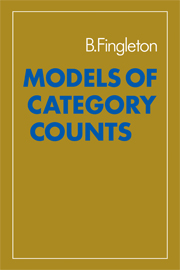Book contents
4 - Sample design and inference
Published online by Cambridge University Press: 05 October 2009
Summary
Sampling models
Up to now we have been largely concerned with identifying structural models and have paid little heed to the fact that one particular sampling model is implicitly assumed. In fact, a number of sampling models could have been adopted, as outlined by Bishop et al (1975, p. 435). This means that we have assumed that the observed data have been collected in one particular way, namely by choosing a sample of a predetermined size at random from a population. Such a scheme will produce an observed frequency in any cell of a multidimensional contingency table that reflects the underlying unknown probability that a randomly chosen member of the population will occupy the cell.
There are in fact three basic interrelated sampling models appropriate to a variety of data collection schemes. One such model is the Poisson distribution, which is applicable if we can assume that the frequency in each of N cells of the multidimensional contingency table is the outcome of N independent Poisson processes. This sampling scheme requires no a priori fixing of the total sample size and, therefore, would be appropriate if the phenomena of interest were observed for a fixed time period, at the end of which the frequencies in each cell, each the outcome of a Poisson process, could be totalled to arrive at a previously unspecified aggregate. Such a scheme would be approximately appropriate if we were conducting a traffic survey to investigate the relationship between vehicle type and whether or not the speed limit was broken, by observing a stretch of road for a given time period.
- Type
- Chapter
- Information
- Models of Category Counts , pp. 67 - 83Publisher: Cambridge University PressPrint publication year: 1984

